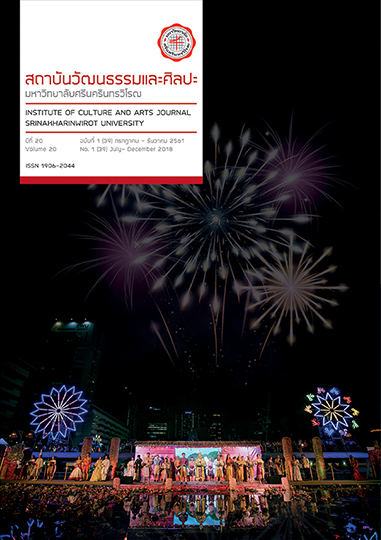Observations of Graphic Symbols for Landscape in Japan
คำสำคัญ:
Graphic symbols, Urban landscapes, Public spaces, Environmental graphic designบทคัดย่อ
This research aims to study the styles and analyzes the graphic design concepts of Japan’s signage system. The researcher focuses on the use of symbols, pictograms and letter marks, and how they are displayed in the public spaces of urban landscapes in Japan. The researcher had surveyed four different tourist attractions that are either cultural attractions or modern attractions in Tokyo, Kyoto, and Osaka: 1. Edo-Tokyo Museum; 2. Tokyo National Museum; 3. Kotokuin Temple; and 4. Shinsaibashi district. The researcher had also conducted a literature review and a research through information media to analyze the design concepts using Shigenobu Kobayashi’s color image scale and environmental graphic design concepts.
It is found that Edo-Tokyo Museum portrays traditional-oriented personality. It represents the conservation of old customs. For Tokyo National Museum, the signs outside the building portray clear and comfortable personality while the cute good luck symbols represent friendliness and sweetness. Kotokuin Temple portrays natural personality. It represents the ideas of prosperity, warmth, politeness, and simplicity. Shinsaibashi district has dynamic personality. It represents movement and enthusiasm. The signs in front of the shops are striking by their sizes and the use of warm color, which make the place look alert all the time. The positioning of the signs makes the messages clear and understandable. The signs are striking, unique and cohesive. The styles are outstanding. The signs are installed in proper places and they are universal, which makes it easy for the tourists to understand. These comply with the idea of environmental graphic design and help promote a good image of Japan.
Downloads
เอกสารอ้างอิง
สืบค้นเมื่อ 4 ตุลาคม 2559 จาก : https://www.v-oneasset.com/index.php/blog/2013/06/Environmental GraphicDesign
ณัฐนันทน์ แนวมาลี. (2557). การเดินทางของการออกแบบเรขศิลป์เชิงข้อมูล. คณะนิเทศศาสตร์. ภาควิชาการออกแบบนิเทศศิลป์. กรุงเทพฯ : มหาวิทยาลัยอัสสัมชัญ.
ธนิส พูนวงศ์ประเสริฐ. (2558). รอยสักในสังคมญี่ปุ่น: ยุคก่อนประวัติศาสตร์ถึงยุคเมจิ. กรุงเทพฯ. วารสารสถาบันวัฒนธรรมและศิลปะ มหาวิทยาลัยศรีนครินทรวิโรฒ, 17(1), 24.
ศุภยาดา ประดิษฐ์ไวทยากร. (2555). พื้นที่สาธารณะ. ปริญญาสถาปัตยกรรมศาสตร์มหาบัณฑิต. สาขาวิชาสถาปัตยกรรม. ภาควิชาสถาปัตยกรรม มหาวิทยาลัยศิลปากร.
Color Combination Image Scale COLOR IMAGE SCALE, SHIGENOBU KOBAYASHI. สืบค้นเมื่อ 1 กรกฎาคม 2559 จาก : https://www.teacher.ssru.ac.th/nichanan_se/pluginfile.php/102/block_html/ content/COLOR%20IMAGE%20SCALE.pdf
Edo-Tokyo Museum.(2559). Logo. สืบค้นเมื่อ 4 ตุลาคม 2559 จาก : https://www.edo-tokyo-museum.or.jp/en/about
Kobayashi, S. (1992) . Color Image Scale. New York: Kodansha USA.
Matcha Japan travel magazine. (2559). เพลิดเพลินไปกับการเดินชมเมืองโดยการสังเกตฝาท่อระบายน้ำและมือจับประตูตามที่ต่างๆ. สืบค้นเมื่อ 25 กรกฎาคม 2559 จาก : https://matcha-jp.com/th/440
Mchhgroup. (2559). THE PAST & THE FUTURE. สืบค้นเมื่อ 1 กันยายน 2559 จาก : https://www.mchhgroup.com/manhole
Shinki. (2559). ภาพนักแสดงคาบูกิ Ichikawa Ebizo no Takemura Sadanoshin บนภาพอุคิโยะเอะ(ukiyoe). สืบค้นเมื่อ 4 ตุลาคม 2559 จาก : https://nekoarena.blog31.fc2.com/blog-date-201401-1.html
Tokyo National Museum.(2559) สัญลักษณ์พิพิธภัณฑ์แห่งชาติโตเกียว (Tokyo National Museum : TNM). สืบค้นเมื่อ 4 ตุลาคม 2559 จาก : https://www.tnm.jp
ดาวน์โหลด
เผยแพร่แล้ว
รูปแบบการอ้างอิง
ฉบับ
ประเภทบทความ
สัญญาอนุญาต
บทความทุกบทความที่ได้รับการตีพิมพ์ถือเป็นลิขสิทธิ์ของวารสารสถาบันวัฒนธรรมและศิลปะ มหาวิทยาลัยศรีนครินทรวิโรฒ



